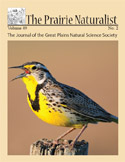Great Plains Natural Science Society

The Prairie Naturalist
Date of this Version
6-2010
Document Type
Article
Citation
The Prairie Naturalist· 42( 1/2): June 2010, pp 67-70
Abstract
The wildland-urban interface (WUI), defined as areas where human development meets undeveloped wildland (Radeloff et al. 2005), is a focal area for humanwildlife interactions in many communities of the western United States, particularly in those areas that have experienced rapid and expansive human population growth. Since 1960, conversion of rural to urban land has more than doubled in the United States (Theobald 2001). The eastern front range of the Rocky Mountains has experienced one of the most rapid urban expansions in the country, with approximately 110,000 hectares of undeveloped rural land being converted to human-developed land every year between 1992 and 1997 (Obermann et al. 2000, Maestas et al. 2001). In grassland remnants within the WUI, many native wildlife species, including black-tailed prairie dogs (Cynomys ludovicanus), persist and land managers are faced with decisions about how to manage these wildlife populations
Included in
Biodiversity Commons, Botany Commons, Ecology and Evolutionary Biology Commons, Natural Resources and Conservation Commons, Systems Biology Commons, Weed Science Commons

